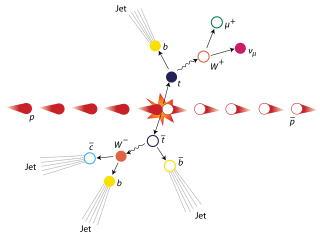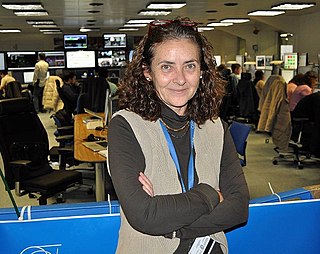
The Standard Model of particle physics is the theory describing three of the four known fundamental forces in the universe and classifying all known elementary particles. It was developed in stages throughout the latter half of the 20th century, through the work of many scientists worldwide, with the current formulation being finalized in the mid-1970s upon experimental confirmation of the existence of quarks. Since then, proof of the top quark (1995), the tau neutrino (2000), and the Higgs boson (2012) have added further credence to the Standard Model. In addition, the Standard Model has predicted various properties of weak neutral currents and the W and Z bosons with great accuracy.

The top quark, sometimes also referred to as the truth quark, is the most massive of all observed elementary particles. It derives its mass from its coupling to the Higgs Boson. This coupling is very close to unity; in the Standard Model of particle physics, it is the largest (strongest) coupling at the scale of the weak interactions and above. The top quark was discovered in 1995 by the CDF and DØ experiments at Fermilab.

Technicolor theories are models of physics beyond the Standard Model that address electroweak gauge symmetry breaking, the mechanism through which W and Z bosons acquire masses. Early technicolor theories were modelled on quantum chromodynamics (QCD), the "color" theory of the strong nuclear force, which inspired their name.
In physical cosmology, baryogenesis is the physical process that is hypothesized to have taken place during the early universe to produce baryonic asymmetry, i.e. the imbalance of matter (baryons) and antimatter (antibaryons) in the observed universe.

A tetraquark, in particle physics, is an exotic meson composed of four valence quarks. A tetraquark state has long been suspected to be allowed by quantum chromodynamics, the modern theory of strong interactions. A tetraquark state is an example of an exotic hadron which lies outside the conventional quark model classification. A number of different types of tetraquark have been observed.

The Underground Area 2 (UA2) experiment was a high-energy physics experiment at the Proton-Antiproton Collider — a modification of the Super Proton Synchrotron (SPS) — at CERN. The experiment ran from 1981 until 1990, and its main objective was to discover the W and Z bosons. UA2, together with the UA1 experiment, succeeded in discovering these particles in 1983, leading to the 1984 Nobel Prize in Physics being awarded to Carlo Rubbia and Simon van der Meer. The UA2 experiment also observed the first evidence for jet production in hadron collisions in 1981, and was involved in the searches of the top quark and of supersymmetric particles. Pierre Darriulat was the spokesperson of UA2 from 1981 to 1986, followed by Luigi Di Lella from 1986 to 1990.
In physics, the pomeron is a Regge trajectory — a family of particles with increasing spin — postulated in 1961 to explain the slowly rising cross section of hadronic collisions at high energies. It is named after Isaak Pomeranchuk.
Hadronization is the process of the formation of hadrons out of quarks and gluons. There are two main branches of hadronization: quark-gluon plasma (QGP) transformation and colour string decay into hadrons. The transformation of quark-gluon plasma into hadrons is studied in lattice QCD numerical simulations, which are explored in relativistic heavy-ion experiments. Quark-gluon plasma hadronization occurred shortly after the Big Bang when the quark–gluon plasma cooled down to the Hagedorn temperature when free quarks and gluons cannot exist. In string breaking new hadrons are forming out of quarks, antiquarks and sometimes gluons, spontaneously created from the vacuum.

The TOTEM experiment is one of the nine detector experiments at CERN's Large Hadron Collider. The other eight are: ATLAS, ALICE, CMS, LHCb, LHCf, MoEDAL, FASER and SND@LHC. It shares an interaction point with CMS. The detector aims at measurement of total cross section, elastic scattering, and diffraction processes. The primary instrument of the detector is referred to as a Roman pot. In December 2020, the D0 and TOTEM Collaborations made public the odderon discovery based on a purely data driven approach in a CERN and Fermilab approved preprint that was later published in Physical Review Letters. In this experimental observation, the TOTEM proton-proton data in the region of the diffractive minimum and maximum was extrapolated from 13, 8, 7 and 2.76 TeV to 1.96 TeV and compared this to D0 data at 1.96 TeV in the same t-range giving an odderon significance of 3.4 σ. When combined with TOTEM experimental data at 13 TeV at small scattering angles providing an odderon significance of 3.4 - 4.6 σ, the combination resulted in an odderon significance of at least 5.2 σ.
Pran Nath is a theoretical physicist working at Northeastern University, with research focus in elementary particle physics. He holds a Matthews Distinguished University Professor chair.

The DØ experiment was a worldwide collaboration of scientists conducting research on the fundamental nature of matter. DØ was one of two major experiments located at the Tevatron Collider at Fermilab in Batavia, Illinois. The Tevatron was the world's highest-energy accelerator from 1983 until 2009, when its energy was surpassed by the Large Hadron Collider. The DØ experiment stopped taking data in 2011, when the Tevatron shut down, but data analysis is still ongoing. The DØ detector is preserved in Fermilab's DØ Assembly Building as part of a historical exhibit for public tours.
The Roman pot is the name of a technique used in accelerator physics. Named after its implementation by the CERN-Rome collaboration in the early 1970s, it is an important tool to measure the total cross section of two particle beams in a collider. They are called pots because the detectors are housed in cylindrical vessels. The first generation of Roman pots was purpose-built by the CERN Central Workshops and used in the measurement of the total cross-section of proton-proton inter-actions in the ISR.
In particle physics, the odderon corresponds to an elusive family of odd-gluon states, dominated by a three-gluon state. When protons collide elastically with protons or with anti-protons at high energies, even or odd numbers of gluons are exchanged. Exchanging an even number of gluons is a crossing-even part of elastic proton–proton and proton–antiproton scattering, while odderon exchange, i.e. exchange of odd number of gluons, corresponds to a crossing-odd term in the elastic scattering amplitude. It took about 48 years to find a definite signal of odderon exchange.
In particle physics, W′ and Z′ bosons refer to hypothetical gauge bosons that arise from extensions of the electroweak symmetry of the Standard Model. They are named in analogy with the Standard Model W and Z bosons.

MoEDAL is a particle physics experiment at the Large Hadron Collider (LHC).

Gian Francesco Giudice is an Italian theoretical physicist working at CERN in particle physics and cosmology.

Riccardo Rattazzi is an Italian theoretical physicist and a professor at the École Polytechnique Fédérale de Lausanne. His main research interests are in physics beyond the Standard Model and in cosmology.

Teresa Rodrigo Anoro was a Spanish scientist who worked in particle physics. She worked at CERN, Fermilab and the Instituto de Física de Cantabria and was professor at the University of Cantabria. Whilst at CERN, Rodrigo worked on the Compact Muon Solenoid and research for the Higgs boson.
Graham Kribs is an American theoretical particle physicist at the University of Oregon. He was elected a Fellow of the American Physical Society in 2015.
Linda Gail Stutte is an experimental elementary particle physicist. After an appointment as a postdoc at Caltech in 1974–76, Stutte was a research staff scientist at the Fermi National Accelerator Laboratory from 1976 through her retirement in 2007. She is known for work on neutrino experiments and her expertise with Fermliab neutrino beam facilities.









